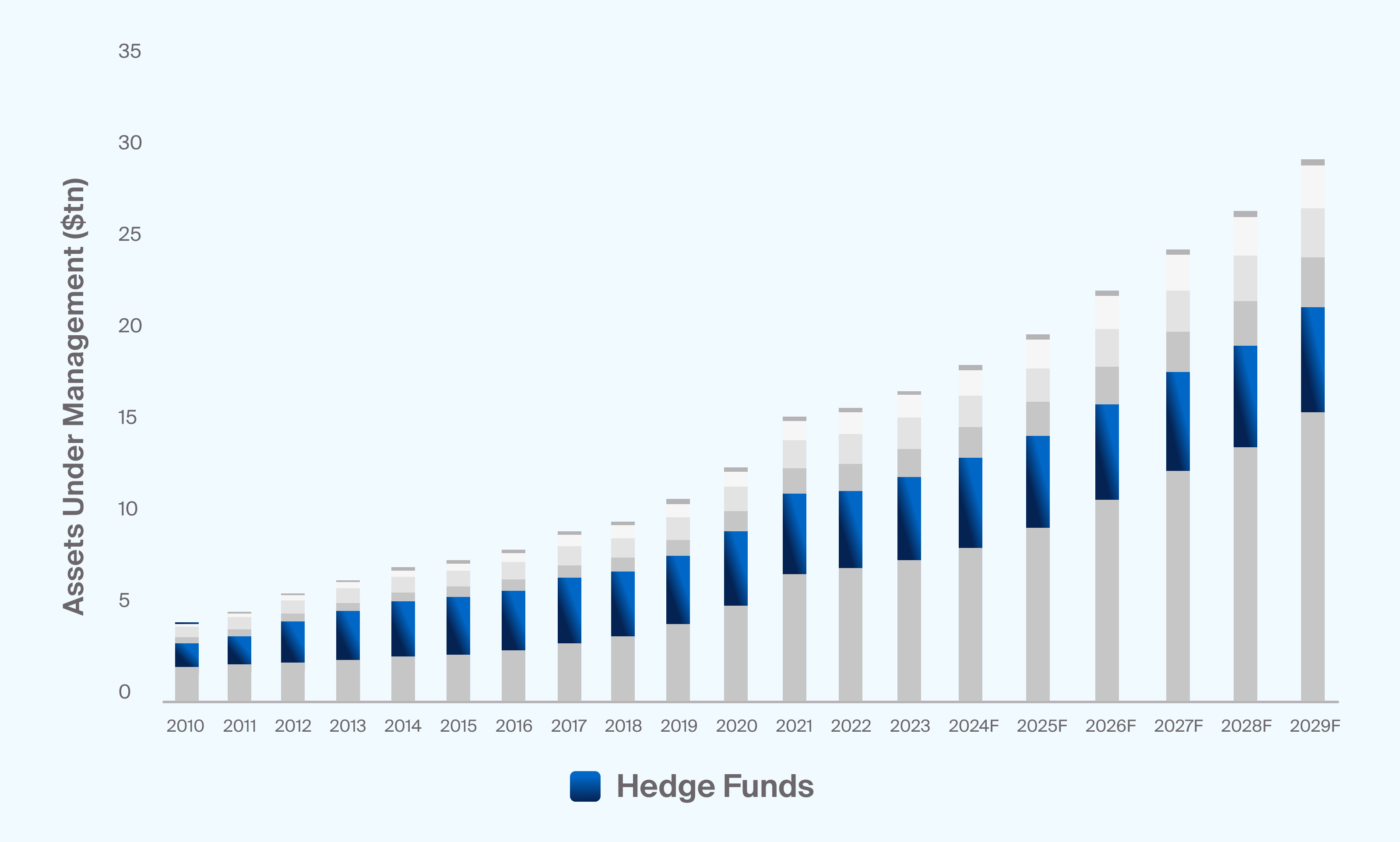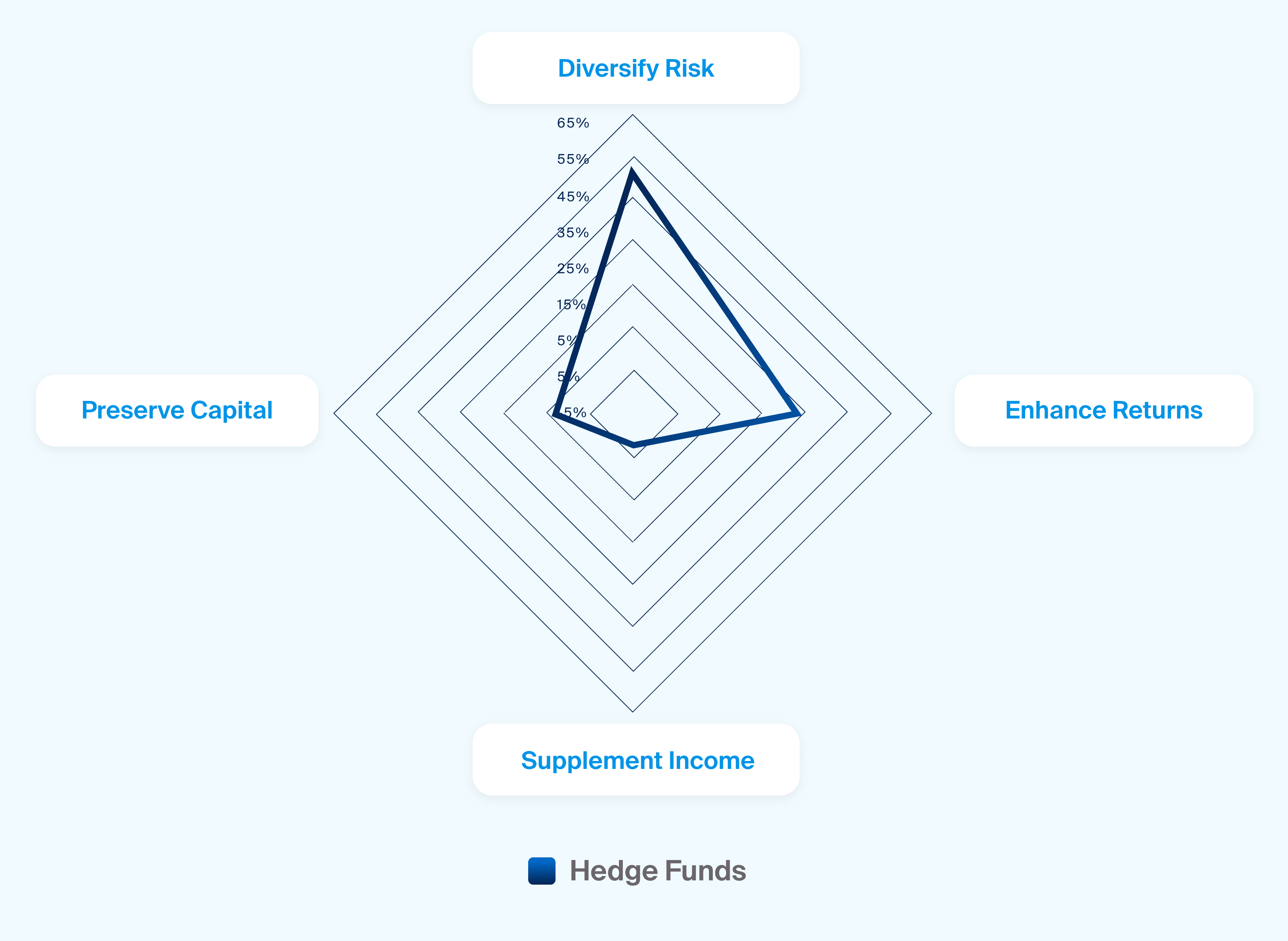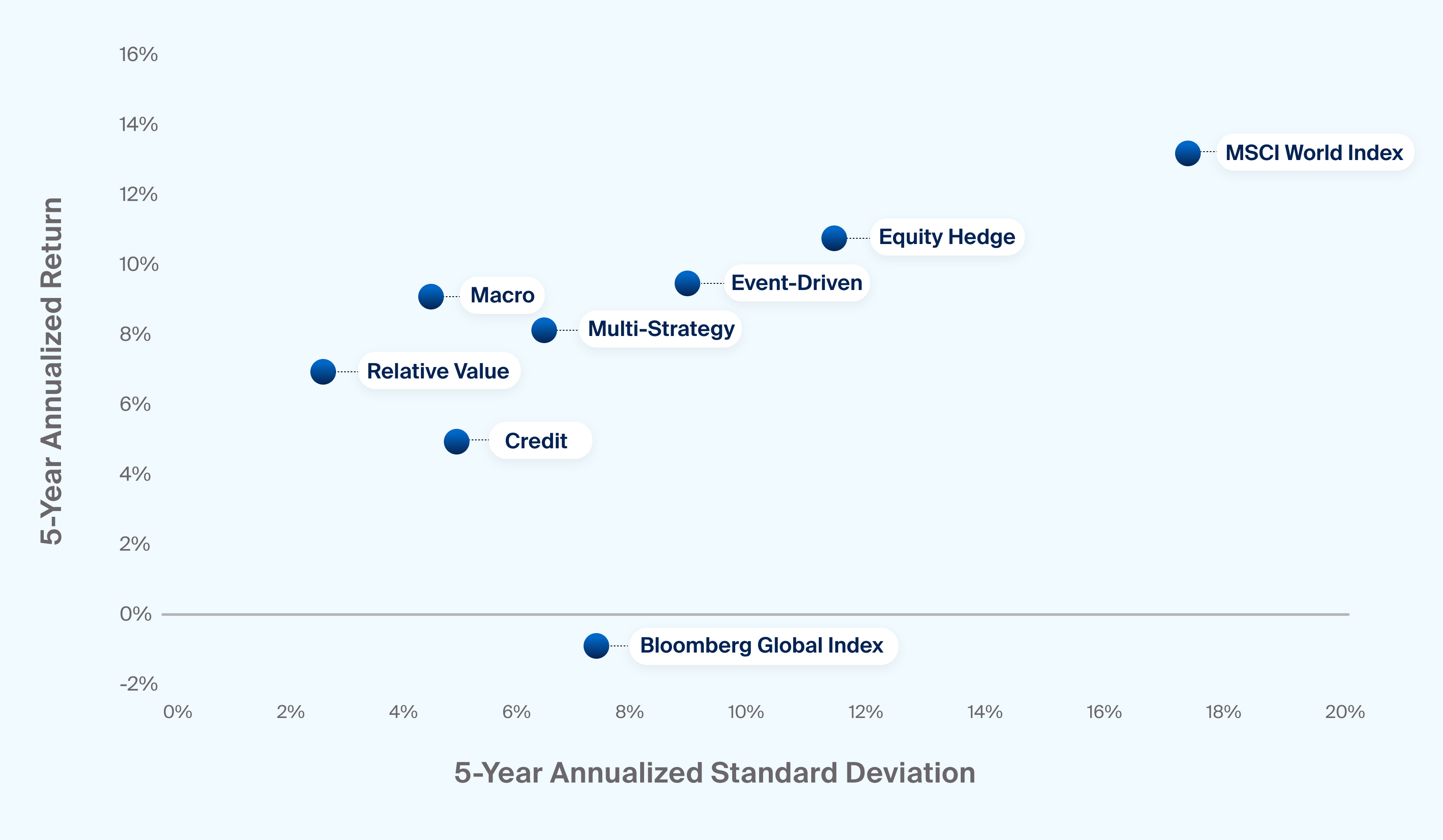Learn about hedge funds and the investment strategies that make up this alternative asset class.
What Are Hedge Funds?
Hedge funds are commonly defined as private, actively managed, pooled investment vehicles. Assets under management (AUM) for hedge funds reached an estimated $4.8 trillion in 2024 and could grow to over $5.7 trillion by 2029, making this alternative asset class the second largest behind private equity by AUM (Exhibit 1).

Source: Preqin, Future of Alternatives 2029; AUM values for 2024 to 2029 forecasted by Preqin.
Hedge funds are commonly defined as private, actively managed, pooled investment vehicles. Assets under management (AUM) for hedge funds reached an estimated $4.8 trillion in 2024 and could grow to over $5.7 trillion by 2029, making this alternative asset class the second largest behind private equity by AUM
As private investments, hedge funds are generally subject to less regulation than many traditional investments, such as mutual funds, potentially giving them more flexibility in terms of the assets they can invest in, their investment style, and the management of the fund. This flexibility can be important because the goal for many hedge funds is to earn positive risk-adjusted performance in all market conditions.
Guidelines for hedge funds tend to have fewer restrictions, often allowing them to employ strategies that are not typically used in mutual funds that can potentially provide additional sources of return. Some of these strategies include dynamic trading strategies that seek to profit from small moves in a market even intra-day; investing in a wide range of assets, including less-liquid securities; using financial instruments, such as options and derivatives; taking short positions in stocks with the goal of profiting from decreases in prices; and using leverage in an effort to enhance returns.
Some of these drivers of potentially higher returns may expose funds to additional risks:
Frequent trading can incur high transaction costs that chip away returns.
Less-liquid assets can be harder to sell during times of market stress.
In contrast to long positions, where the downside is limited to a stock’s decline in value to zero, short positions have an unlimited downside because a stock can trade infinitely higher.
What Role Might Hedge Funds Play in a Portfolio?
Some advisors may be concerned that the returns from traditional asset classes in recent years may not be easily repeated in the coming years, particularly as inflation and interest rates remain uncertain. As a result, they may look to diversify their portfolios and aim to understand how hedge funds fit into a broader asset allocation strategy.
While one reason to consider hedge funds is the potential to generate higher returns than traditional assets classes, many hedge funds are managed by “hedging” or offsetting risks. Such tactics potentially generate returns that are less correlated to the market environment, which can potentially improve the risk-adjusted returns of a portfolio (Exhibit 2). The sources of return for many hedge fund strategies may also be different and more diverse than traditional equity and bond allocations, potentially resulting in less correlation to these asset classes.

Source: CAIS and Mercer, “The State of Alternative Investments in Wealth Management 2023,” December 2023.
While one reason to consider hedge funds is the potential to generate higher returns than traditional assets classes, many hedge funds are managed by “hedging” or offsetting risks, making returns less correlated to the market environment, which can potentially improve the risk-adjusted returns of a portfolio.
Who Can Invest in Hedge Funds?
Hedge funds are appealing due to their flexibility and high earning potential, but the associated risk level makes them unsuitable for the general public. As such, the Securities and Exchange Commission (SEC) has leveraged the Securities Act of 1933 and Regulation D to outline regulatory restrictions on who is qualified to invest in hedge funds. They include:
Institutional Investors: These are entities that manage high-volume investments for others, including pension funds, endowments, foundations, insurance companies, and more.
Accredited Investors: These are defined by the SEC as individuals with a net worth of more than $1 million, or an income over $200,000 (single) or $300,000 (joint) for at least two years.
Qualified Purchasers: The Investment Company Act of 1940 defines qualified purchasers as individuals or families with a minimum of $5 million in assets, or entities with at least $25 million in assets.
Fund of Hedge Funds: A fund of funds (FOF) is a professionally managed investment vehicle that collects a pool of capital and then distributes it across multiple hedge funds.
Due to their complex nature and the possibility of becoming illiquid, hedge fund management is allocated to experienced investors with high risk tolerance who can supply the required due diligence.
How Do Hedge Funds Work?
Hedge funds work by pooling money from investors and managing it across numerous strategies like short-selling, derivatives, and arbitrage. Hedge fund managers are generally very experienced and must be qualified to make high-risk investment decisions.
Key Components of a Hedge Fund Structure
Most hedge funds are set up as a limited partnership, a business structure in which there are a minimum of two partners who own the company. However, while there may be multiple members, only one partner runs the company. The components of a hedge fund limited partnership include:
General Partner: The general partner (GP) is the qualified hedge fund manager who makes decisions on asset management and risk management, while also performing the day-to-day operations of the business.
Limited Partner: Limited partners (LPs) are the funding providers. They provide the capital to the GP, and then receive returns on their investment.
How Hedge Funds Make Money
At its most basic level, hedge funds make money by investing funds using potentially risky strategies to generate positive absolute returns. There are two primary ways a hedge fund generates money, including:
Performance Fees: These are incentivized fees that are only collected when the hedge fund is performing well and generating positive returns. Performance fees are generally around 20% of the fund's returns over a specified hurdle rate.
Management Fees: Management fees are paid regardless of whether the hedge fund generates positive returns. These fees cover operating expenses and overhead. The standard is 2%, but they may fall anywhere between 1-4%.
What Are Some Common Types of Hedge Funds?
While each hedge fund will have its unique investment strategy, there are some broad categories, each with different risk and return characteristics.
Global Macro Funds
Global macro hedge funds broadly aim to profit from market swings caused by political or economic events; they seek to maximize returns in periods of high market volatility and low liquidity.
Equity Hedge Funds
Equity hedge funds are the most common strategy used by managers. It often combines both long and short positions in stocks with the objective of generating returns on both, while also seeking to minimize exposure to the market.
Event-Driven Funds
Event-driven strategies tend to focus on mispriced securities that may have catalysts, such as mergers, acquisitions, reorganizations, bankruptcies, or other unique corporate actions, that could help realize their true value.
Relative Value Funds
Relative value strategies typically seek to generate returns by exploiting pricing inefficiencies between related financial instruments such as stocks or bonds.
Credit Strategies
Credit strategies generally focus on arbitrage opportunities, such as between junior and senior debt of the same issuer, between securities with similar credit profiles from different issuers, or within more complex structures.
Multi-Strategy Funds
Multi-strategy funds utilize a variety of hedge fund strategies in a single portfolio. The goal of a multi-strategy funds is diversification. To achieve this, an investment adviser may combine tactics like long/short equity, global macro, and arbitrage into one portfolio.
Single-Strategy Funds
The reverse of multi-strategy funds, this type utilizes a single strategy to capitalize on the unique experience and knowledge of the investment manager. They are also referred to as single-manager funds.

Source: Preqin 2025 Global Report: Hedge Funds, Dec. 10, 2024
The most common strategies used by Hedge Fund managers.
Risks and Considerations When Investing in Hedge Funds
Due to their complex nature, hedge funds are not something one invests in lightly. Hedge fund investment is a complicated and nuanced process, and there are many considerations you will need to make if you’re thinking of entering the hedge fund industry. These considerations include:
Manager Selection
Manager skill can be important to a hedge fund’s success, meaning advisors should carefully evaluate managers.
Performance Measurement
Generally, hedge funds are evaluated using an absolute return standard, such as a risk-free return level plus a spread, and therefore, tend to perform independently from the market or other benchmarks.
Fees
Fee structures vary greatly across the industry, but hedge fund fees are generally higher than those for traditional assets and tend to include an additional performance component. A common fee structure is “2 and 20,” which is a 2% management fee applied each year to the total assets under management and a 20% incentive fee (or performance fee) charged on the profits earned over a hurdle rate.
Liquidity
Investments in hedge funds are generally much less liquid than investment vehicles associated with traditional asset classes, such as mutual funds and ETFs, because they do not trade on an exchange and are not open-ended funds with daily liquidity. Furthermore, in order to properly execute their strategies, many hedge funds have lockup periods of about one to two years when investors are unable to withdraw or sell back investments. However, hedge funds may be more liquid than many other alternative investments due to more liquid underlying assets and shorter lockups.
Regulation
Disclosures for hedge funds are often not mandated, reviewed, or approved by regulatory bodies. As a result, advisors need to conduct independent analysis and evaluation of a hedge fund’s underlying investments or strategies to compensate for the lack of transparency. This can differ significantly from a mutual fund, which is a highly regulated investment vehicle offering relatively transparent, frequent, and standardized reporting.
Leverage
This form of borrowing is used by many hedge funds in an effort to increase the power of every dollar contributed to the fund by investors. A variety of financial instruments, such as options, swaps, and futures, can add leverage to a portfolio. Advisors should understand that these instruments come with costs and increase the risk of the portfolio because leverage can also amplify losses.
Hedge funds are a complex, but powerful, investment vehicle, when left in the right hands. For advisors looking to diversify away from traditional markets while taking on more risk, hedge funds could serve as a valuable tool in a broader portfolio.





